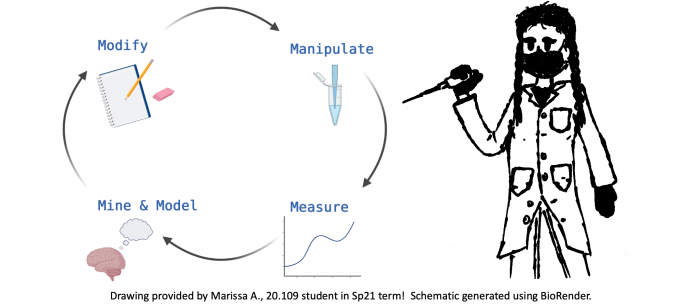20.109(F21):M2D5
Contents
Introduction
Protocols
Part 2: Prepare samples for DSF assay
As in the previous laboratory session, you will prepare master mixes for the conditions you will test. Because the master mixes for the DSF assay are more complicated, the below chart will assist you in completing the required calculations for each reaction. You will eventually make master mixes for each reaction, with enough volume to measure each in triplicate.
| Reagent (stock concentration) | Final concentration of stock reagent in reaction | Volume of stock reagent in reaction |
|---|---|---|
| FKBP12 (191.6 μg/mL) | 1 μg/30 μL reaction | |
| DMSO (3%) | 0.1% | |
| rapamycin (150 μM) | 5 μM | |
| ligand, [low] (90 μM) | 3 μM | |
| ligand, [high] (900 μM) | 30 μM | |
| dye (30X) | 1X | |
| PBS (1X) | add for a total of 30 μL reaction | dependent upon master mix |
- Perform the necessary calculations to complete the above chart for a total reaction volume of 30 μL.
- Confirm your values with the teaching faculty before proceeding.
- Each team will setup triplicate reactions for 7 different conditions:
- Condition 1: no protein AND DMSO (internal control)
- Condition 2: FKBP12 AND DMSO (internal control)
- Condition 3: FKBP12 AND rapamycin (5 μM)
- Condition 4: FKBP12 AND ligand #1, (3 μM)
- Condition 5: FKBP12 AND ligand #1, (30 μM)
- Condition 6: FKBP12 AND ligand #2, (3 μM)
- Condition 7: FKBP12 AND ligand #2, (30 μM)
- Generate a chart, or list, that details what reagents will be in each master mix for Conditions #1 - #7 listed above.
- All reactions will contain dye.
- Only reactions without rapamycin or ligand will contain DMSO.
- Include the volume of each reagent (for a final volume of 3.25 the reaction volume, which is 30 μL) as each condition will be tested in triplicate.
- Again, confirm your values with the teaching faculty before proceeding.
- Obtain the appropriate aliquots from the front laboratory bench.
- Use the values calculated in Step #3 to prepare your master mixes in well-labeled 1.5 mL centrifuge tubes on ice.
- You will add all reagents except FKBP12 protein, as the teaching faculty will add the protein to the samples immediately prior to measuring the fluorescence signal.
- When you have prepared your master mixes, take them to the front laboratory bench.
- Be sure that all tubes are clearly labeled!
Part 3: Review journal article
Critically a and discuss the following journal article with your laboratory partner:
Amberg-Johnson et al. "Small molecule inhibition of apicomplexan FtsH1 disrupts plastid biogenesis in human pathogens." eLife. (2017) 6:e29865.
The initial experiment presented by Amberg-Johnson et. al. shows the effect of actinonin on apicoplast biogenesis. The apicoplast is an essential plastid organ that is a key target for drug development in research focused on malaria treatment. Actinonin was identified in large-scale screen of compounds known to inhibit growth of parasite. The subsequent experiments completed in this research served to uncover the mechanism-of-action of actinonin is it pertains to disruption of the apicoplast.
In the context of your research, this article focuses on the next step experiments that can be performed after a drug candidate is discovered from a screen. Though you can use this article as guidance as you consider the experiments that could follow your screen, remember that the specific next step experiments should be related to the protein target and drug candidate(s) identified in your project. For this exercise, the focus in on how the data are organized and presented.
In your laboratory notebook, complete the following with your partner:
- Why is the apicoplast a promising target for anti-malarial drug development?
- Why have attempts at developing broadly effective drugs that target the apicoplast been unsuccessful?
- Why is the approach used by the researchers in this article more promising?
- List the figures that are included in the article. For each figure:
- What is the main conclusion / finding in each figure?
- Which panel best supports the main conclusion / finding? Is more than one panel needed to fully support the main conclusion?
- Are you convinced by the data? Do you agree with the main conclusion?
- Are the figures organized in a coherent story?
- Write transition statement that connect each figure to the next. A transition statement should very briefly summarize the findings of a figure and state what those findings motivated the research to do next (ie what is the next experiment?).
Reagent list
- DSF dye (Thermo Fisher)
- ligands (Chembridge)
Next day: Perform secondary assay to test putative small molecule binders
